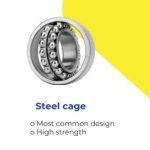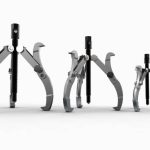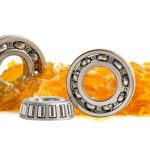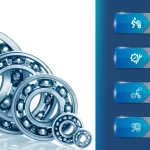For all sorts of industrial machinery, bearing load capacity stands out as a pivotal concept, dictating the performance and longevity of various applications. This capacity refers to the maximum load a bearing can endure while maintaining proper functionality. The significance of selecting bearings with suitable load capacity cannot be overstated, as it directly influences the efficiency, safety, and reliability of diverse mechanical systems across industries.
Types of Loads on Bearings
Bearings can experience various types of loads depending on the application they’re used in. The primary types of loads that bearings encounter are:
Radial Load: This type of load acts perpendicular to the axis of rotation. Radial loads are typical in applications where the load is applied sideways to the rotating shaft. Some practical examples of radial loads are:
- In a bicycle wheel, the weight of the rider and the bike creates a radial load on the wheel bearings.
- In an electric motor, the weight of the rotor and any additional radial forces due to the belt or pulley system can create radial loads on the motor bearings.
Axial Load: Axial loads act parallel to the axis of rotation. These loads are common in applications where the load is applied along the direction of shaft movement. Practical examples include:
- In a car’s wheel hub, the thrust generated during acceleration, braking, or cornering creates axial loads on the wheel bearings.
- In a lathe machine, the cutting forces exerted by the tool against the workpiece create axial loads on the spindle bearings.
Combined Load: In many real-world applications, bearings experience a combination of radial and axial loads simultaneously. These combined loads require bearings capable of handling both types of loads. Practical examples of combined loads include:
- In a car’s suspension system, wheel bearings experience both radial loads from the weight of the vehicle and axial loads from cornering and braking forces.
- In a wind turbine, the main shaft bearings experience radial loads from the weight of the rotor and axial loads from wind forces acting on the blades.
Moment Load: Moment loads occur when a force is applied perpendicular to the bearing’s axis at some distance from the centerline. These loads create bending moments that can lead to additional stress on the bearing. Practical examples include:
- In a robotic arm, the weight of the arm and any payloads creates moment loads on the joint bearings as the arm moves.
- In a crane, the load hanging from the crane hook creates moment loads on the slew bearing as the crane rotates.
Understanding the types of loads a bearing experiences is crucial for selecting the right bearing type and size for a given application. Bearings must be designed to withstand the expected loads while providing smooth operation and long service life.
Understanding Load Ratings
Load ratings refer to the maximum allowable loads that a bearing can support under specific operating conditions without experiencing excessive wear or failure. These ratings are crucial for selecting the appropriate bearing for a particular application. Load ratings help ensure that bearings operate within safe limits and provide reliable performance throughout their service life.
There are several types of load ratings associated with bearings:
- Dynamic Load Rating (C): The dynamic load rating represents the maximum load that a bearing can withstand under continuous operation without experiencing fatigue failure. It is expressed in units of force (such as newtons or pounds) and is based on a defined number of revolutions or hours of operation. Bearings subjected to dynamic loads greater than their rated capacity may experience premature wear or failure.
- Static Load Rating (Co): The static load rating indicates the maximum load that a bearing can support without undergoing permanent deformation or damage while stationary. Unlike the dynamic load rating, the static load rating does not consider rotation or movement. It is typically higher than the dynamic load rating and is expressed in the same units of force.
- Axial Load Rating (Ca): The axial load rating specifies the maximum axial load that a radial bearing can support without significant reduction in performance or premature failure. This rating is relevant for bearings designed to primarily handle radial loads but can also withstand limited axial loads. Axial load ratings are crucial in applications where the bearing may experience both radial and axial loads.
- Thrust Load Rating (C0a): Thrust load ratings apply to bearings specifically designed to support predominantly axial or thrust loads, such as thrust bearings. These ratings indicate the maximum axial load that the bearing can withstand without failure. Thrust load ratings are essential for applications where bearings primarily carry axial loads, such as in gearboxes and automotive transmissions.
- Combined Load Rating: In some cases, bearings may experience combined radial and axial loads simultaneously. Combined load ratings provide information on the maximum allowable combined load capacity of the bearing. These ratings ensure that bearings can handle both radial and axial loads without compromising performance or longevity.
It’s important to consider the appropriate load ratings based on the specific operating conditions and load characteristics of the application. Using bearings with adequate load ratings helps prevent premature failure, ensures reliable performance, and extends the service life of machinery and equipment.
Types of Bearings and Load Capacity
Different types of bearings, such as ball bearings and roller bearings, exhibit varying load-carrying capabilities.
Type of Bearing | Radial Load Capacity | Axial Load Capacity | Combined Load Capacity |
Ball Bearings | Moderate to high, depending on bearing size and design. | Moderate, but some designs can handle higher axial loads with proper arrangements like angular contact ball bearings. | Can handle combined radial and axial loads to varying degrees, depending on design. |
Roller Bearings | High, especially for cylindrical and tapered roller bearings. | Moderate to high, depending on bearing type and arrangement. | Can handle combined radial and axial loads efficiently, especially spherical roller bearings and tapered roller bearings. |
Thrust Bearings | High, specifically designed to handle predominantly axial loads. | Generally low, but some designs like tapered roller thrust bearings can handle limited radial loads. | Primarily designed for axial loads, but some types can handle limited radial loads in combination with axial loads. |
Needle Bearings | Moderate to high, depending on bearing size and design. | Generally low to moderate. | Can handle combined radial and axial loads, especially in applications with limited space. |
Plain Bearings (Bushings) | Moderate to high, depending on material and design. | Generally low to moderate, depending on application and arrangement. | Can handle combined radial and axial loads in various configurations. |
Spherical Bearings | Moderate to high, especially for spherical roller bearings. | Moderate to high, depending on bearing type and design. | Efficiently handles combined radial and axial loads, suitable for applications with misalignment. |
Angular Contact Bearings | Moderate to high, depending on bearing size and contact angle. | Moderate to high, specifically designed to handle both radial and axial loads. | Well-suited for combined radial and axial loads, with higher capacities compared to standard ball bearings. |
These load capacities are general guidelines, and actual load capacities may vary based on factors such as bearing size, material, design, lubrication, operating conditions, and application-specific requirements. It’s essential to refer to manufacturer specifications and technical documentation for precise load capacity information for specific bearing models and applications.
Conclusion
Bearing load capacity plays a pivotal role in the selection and performance of bearings across diverse applications. Engineers must carefully consider load requirements and choose bearings with appropriate load ratings to ensure optimal functionality, reliability, and longevity of mechanical systems.
FAQ's
What is a maximum capacity bearing?
A maximum capacity bearing is designed to accommodate higher radial loads than standard bearings of similar size. These bearings feature a larger number of balls or rollers and optimized internal geometries to enhance load-carrying capabilities.
What is the bearing load strength?
Bearing load strength refers to the maximum load a bearing can withstand without experiencing failure or permanent deformation. This strength is determined by factors such as material properties, design, and load-carrying capacity under different operating conditions.
What is bearing static capacity?
Bearing static capacity, also known as static load rating, indicates the maximum load a bearing can support while stationary. It is essential for applications where bearings experience prolonged static or low-speed conditions, such as heavy machinery or structural supports.



















